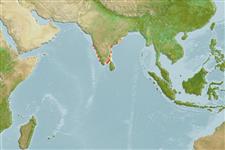Teleostei (teleosts) >
Eupercaria/misc (Various families in series Eupercaria) >
Sillaginidae (Smelt-whitings)
Etymology: Sillago: From a locality in Australia.
Eponymy: S G Vincent was a Technical Officer at the Central Marine Fisheries Research Institute, Cochin, India, and collected the holotype (1980). [...] (Ref. 128868), visit book page.
Environment: milieu / climate zone / depth range / distribution range
Ecology
Marine; brackish; demersal; amphidromous (Ref. 51243); depth range 0 - 10 m (Ref. 6205). Tropical; 19°N - 8°N, 70°E - 85°E (Ref. 6205)
Indian Ocean: East and west coast of India. Very similar in external morphology to Sillago sihama.
Size / Weight / Age
Maturity: Lm ? range ? - ? cm
Max length : 30.0 cm SL male/unsexed; (Ref. 6205); common length : 20.0 cm TL male/unsexed; (Ref. 3504)
Dorsal spines (total): 12; Dorsal soft rays (total): 21 - 23; Anal spines: 2; Anal soft rays: 22 - 24; Vertebrae: 34. Swim bladder with a single posterior extension, a short bulbous projection anteriorly with one to three anterolobate or recurved projections; no tubular extensions anteriorly. Body color is uniform pale tan, with the second dorsal fin spotted.
Occur with S. sihama apparently in mixed schools on muddy substrates. Oviparous (Ref. 205). Females, measuring 25 to 28 cm, have been reported to be running ripe in late January to early February. Is a potential aquaculture species in impoundments and tidal ponds. Growth is reported to be rapid (Ref. 6205).
Life cycle and mating behavior
Maturity | Reproduction | Spawning | Eggs | Fecundity | Larvae
McKay, R.J., 1992. FAO Species Catalogue. Vol. 14. Sillaginid fishes of the world (family Sillaginidae). An annotated and illustrated catalogue of the sillago, smelt or Indo-Pacific whiting species known to date. Rome: FAO. FAO Fish. Synop. 125(14):87p. (Ref. 6205)
IUCN Red List Status (Ref. 130435: Version 2024-1)
Threat to humans
Harmless
Human uses
Fisheries: minor commercial; aquaculture: likely future use
Tools
Special reports
Download XML
Internet sources
Estimates based on models
Preferred temperature (Ref.
123201): 28.1 - 28.6, mean 28.5 °C (based on 68 cells).
Phylogenetic diversity index (Ref.
82804): PD
50 = 0.5000 [Uniqueness, from 0.5 = low to 2.0 = high].
Bayesian length-weight: a=0.00603 (0.00357 - 0.01017), b=3.07 (2.92 - 3.22), in cm total length, based on LWR estimates for this species & Genus-body shape (Ref.
93245).
Trophic level (Ref.
69278): 3.3 ±0.4 se; based on size and trophs of closest relatives
Resilience (Ref.
120179): High, minimum population doubling time less than 15 months (Preliminary K or Fecundity.).
Fishing Vulnerability (Ref.
59153): Low to moderate vulnerability (27 of 100).
